List of wars involving the United States
The neutrality of this article is disputed. (August 2021) |
This is a list of wars and rebellions involving the United States of America.[1] Currently, there are 93 wars on this list, 3 of which are ongoing.
- USA defeat/Ally defeat
- USA victory
- Another result (e.g. a treaty or peace without a clear result, status quo ante bellum, result of civil or internal conflict, result unknown or indecisive)
- Ongoing conflict
18th-century wars[]
| Conflict | Combatant 1 | Combatant 2 | Result for the United States and its Allies | Presidents of the United States |
|---|---|---|---|---|
| American Revolutionary War (1775–1783) Location: Eastern North America, Southern North America, Gibraltar, India, Caribbean Sea, and the Atlantic  The Battle of Long Island, August 27, 1776 |
Watauga Association
|
|
US-allied victory
|
President of the Continental Congress in American Revolutionary War:
|
| Cherokee–American wars (1776–1795) Part of the American Indian Wars Location: Old Southwest  Abduction of Daniel Boone's daughter by the Cherokee |
US-allied victory | President of the Continental Congress in Cherokee –American wars:
Presidents of the United States:
| ||
| Northwest Indian War (1785–1793) Part of the American Indian Wars Location: Northwest Territory 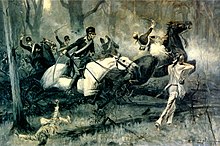 The Battle of Fallen Timbers |
Western Confederacy
show
List
|
US-allied victory
|
George Washington | |
| Quasi-War (1798–1800) Location: Atlantic Ocean, the Caribbean, the Indian Ocean and the Mediterranean |
Co-belligerent: |
|
Convention of 1800
|
John Adams |
19th-century wars[]
| Conflict | Combatant 1 | Combatant 2 | Result for the United States and its Allies | Presidents of the United States |
|---|---|---|---|---|
| First Barbary War (1801–1805) Part of the Barbary Wars Location: Mediterranean Sea off the coast of Tripoli  |
US-allied victory | Thomas Jefferson | ||
| Tecumseh's War (1810–1813) Part of the American Indian Wars and the War of 1812 Location: Northwest River Ohio  The Battle of Tippecanoe |
Tecumseh's Confederacy
show
List |
US victory | James Madison | |
| War of 1812 (1812–1815) Location: Eastern and Central North America  General Andrew Jackson stands on the parapet of his makeshift defenses as his troops repulse attacking Highlanders, by painter Edward Percy Moran in 1910. |
Creek Allies |
show
List |
Inconclusive/Other Result
| |
| Creek War (1813–1814) Part of the American Indian Wars and the War of 1812 Location: Southern United States  The Battle of Horseshoe Bend, 1814 |
Lower Creeks |
Red Stick Creek | US-allied victory | |
| Second Barbary War (1815) Part of the Barbary Wars Location: Mediterranean Sea and the Barbary States  Decatur's squadron off Algiers |
US victory | |||
| First Seminole War (1817–1818) Part of the Seminole Wars and the American Indian Wars Location: Pensacola, Spanish Florida  |
Seminole
|
US victory
|
James Monroe | |
| Arikara War (1823) Part of the American Indian Wars Location: Missouri River 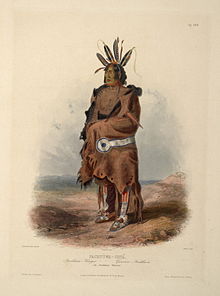 An Arikara warrior |
Sioux |
Arikara | Inconclusive/Other Result
| |
| Winnebago War (1827) Part of the American Indian Wars Location: Illinois and Michigan Territory |
Prairie La Crosse Ho-Chunks with a few allies |
US-allied victory
|
John Quincy Adams | |
| Black Hawk War (1832) Part of the American Indian Wars Location: Illinois and Michigan Territory  Native women and children fleeing the Battle of Bad Axe |
Ho-Chunk Menominee Potawatomi |
Black Hawk's British Band Ho-Chunk and Potawatomi allies |
US-allied victory
|
Andrew Jackson |
| Texas Revolution (1835–1836) Location: Texas  Fall of the Alamo |
|
Texan victory
|
Martin Van Buren | |
| Second Seminole War (1835–1842) Part of the Seminole Wars and the American Indian Wars Location: Florida, United States  U.S. Marines search for Seminoles in the Everglades |
Seminole | US victory
|
Martin Van Buren (March 4, 1837 – March 4, 1841)
William Henry Harrison(March 4, 1841 – April 4, 1841) John Tyler (April 4, 1841 –March 4, 1845) | |
| Mexican–American War (1846–1848) Location: Texas, New Mexico, California and Mexico  2nd Dragoons charge the enemy at the Battle of Resaca de la Palma, 1846 |
US-allied victory
|
James K. Polk | ||
| Cayuse War (1847–1855) Part of the American Indian Wars Location: Oregon 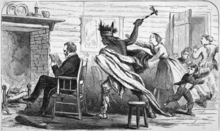 The Whitman Massacre. |
Cayuse | US victory
|
James K. Polk (March 4, 1845 – March 4, 1849)
Zachary Taylor (March 4, 1849 – July 9, 1850) Millard Fillmore (July 9, 1850 – March 4, 1853) Franklin Pierce (March 4, 1853 – March 4, 1857) | |
| Apache Wars (1849–1924) Part of the Texas–Indian wars and the American Indian Wars Location: Southwestern United States  U.S. Cavalry dash for cover while fighting Apaches, by F. Remington |
Apache Ute Yavapai |
US victory
|
James K. Polk (March 4, 1845 – March 4, 1849)
Zachary Taylor (March 4, 1849 – July 9, 1850) Millard Fillmore (July 9, 1850 – March 4, 1853) Franklin Pierce (March 4, 1853 – March 4, 1857) James Buchanan (March 4, 1857 – March 4, 1861) Abraham Lincoln (March 4, 1861 – April 15, 1865) Andrew Johnson (April 15, 1865 – March 4, 1869) Ulysses S. Grant (March 4, 1869 – March 4, 1877) Rutherford B. Hayes (March 4, 1877 – March 4, 1881) James A. Garfield (March 4, 1881 – September 19, 1881) Chester A. Arthur (September 19, 1881 – March 4, 1885) Grover Cleveland (March 4, 1885 – March 4, 1889) Benjamin Harrison (March 4, 1889 – March 4, 1893) Grover Cleveland (March 4, 1893 – March 4, 1897) William McKinley (March 4, 1897 – September 14, 1901) Theodore Roosevelt (September 14, 1901 – March 4, 1909) William Howard Taft (March 4, 1909 – March 4, 1913) Woodrow Wilson (March 4, 1913 – March 4, 1921) Warren G. Harding (March 4, 1921 – August 2, 1923) Calvin Coolidge (August 2, 1923 – March 4, 1929) | |
| Bleeding Kansas (1854–1861) Location: Kansas and Missouri  Sacking of Lawrence in 1856 |
Anti-slavery settlers (Free-Staters) |
Pro-slavery settlers (Border Ruffians) | Free-Stater victory.
|
Franklin Pierce (March 4, 1853 – March 4, 1857)
James Buchanan (March 4, 1857 – March 4, 1861) |
| Puget Sound War (1855–1856) Part of the American Indian Wars Location: Washington |
Snoqualmie |
Nisqually Muckleshoot Puyallup Klickitat Haida Tlingit |
US victory
|
Franklin Pierce |
| Rogue River Wars (1855–1856) Location: Rogue Valley |
Rogue River people | US victory
| ||
| Third Seminole War (1855–1858) Part of the Seminole Wars and the American Indian Wars Location: Pensacola, Florida |
Seminole | US victory
|
Franklin Pierce (March 4, 1853 – March 4, 1857)
James Buchanan (March 4, 1857 – March 4, 1861) | |
| Yakima War (1855–1858) Part of the American Indian Wars Location: Washington Territory  Seattleites evacuate to the town blockhouse as USS Decatur opens fire on advancing tribal forces. |
Snoqualmie |
Yakama Walla Walla tribe Umatilla tribe Nez Perce tribe Cayuse tribe |
US victory | Franklin Pierce (March 4, 1853 – March 4, 1857)
James Buchanan (March 4, 1857 – March 4, 1861) |
| Second Opium War (1856–1859) Part of the Opium Wars Location: China  |
US victory
|
Franklin Pierce (March 4, 1853 – March 4, 1857)
James Buchanan (March 4, 1857 – March 4, 1861) | ||
| Utah War (1857–1858) Part of the Mormon wars Location: Utah Territory and Wyoming |
Deseret/Utah Mormons (Nauvoo Legion) | Inconclusive/Other Result
|
Franklin Pierce (March 4, 1853 – March 4, 1857)
James Buchanan (March 4, 1857 – March 4, 1861) | |
| Navajo Wars (1858–1866) Part of the American Indian Wars Location: New Mexico 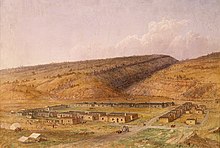 Fort Defiance |
US victory
|
Franklin Pierce (March 4, 1853 – March 4, 1857)
James Buchanan (March 4, 1857 – March 4, 1861) Abraham Lincoln (March 4, 1861 – April 15, 1865) | ||
| John Brown's Raid on Harpers Ferry (1859) Part of pre-Civil War conflicts Location: West Virginia  |
Abolitionist Insurgents | US victory | James Buchanan (March 4, 1857 – March 4, 1861) | |
| First and Second Cortina War (1859–1861) Location: Texas and Mexico |
|
US-allied victory | James Buchanan | |
| Paiute War (1860) Part of the American Indian Wars Location: Pyramid Lake, Nevada |
Paiute Shoshone Bannock |
US victory | James Buchanan | |
| American Civil War (1861–1865) Location: Southern United States, Indian Territory, Northeastern United States, Western United States, Atlantic Ocean  The Battle of Antietam, by Kurz & Allison. |
US victory
|
Abraham Lincoln | ||
| Yavapai Wars (1861–1875) Part of the American Indian Wars Location: Arizona  Rescue of Lt. Charles King |
Yavapai Apache Yuma Mohave |
US victory |
Abraham Lincoln (March 4, 1861 – April 15, 1865) Andrew Johnson (April 15, 1865 – March 4, 1869) Ulysses S. Grant (March 4, 1869 – March 4, 1877) | |
| Dakota War of 1862 (1862) Part of the American Indian Wars Location: Minnesota and Dakota  The Siege of New Ulm, Minnesota on August 19, 1862 |
US victory | Abraham Lincoln | ||
| Colorado War (1863–1865) Part of the American Indian Wars Location: Colorado, Wyoming, and Nebraska |
Inconclusive/Other Result
| |||
| Snake War (1864–1868) Part of the American Indian Wars Locations: Oregon, Nevada, California, and Idaho |
Paiute Bannock Shoshone |
US victory | Abraham Lincoln (March 4, 1861 – April 15, 1865)
Andrew Johnson (April 15, 1865 – March 4, 1869) | |
| Powder River War (1865) Part of the American Indian Wars Location: Powder River State |
Inconclusive |
Andrew Johnson | ||
| Red Cloud's War (1866–1868) Part of the American Indian Wars Location: Powder River State  The Fetterman Massacre |
Lakota-allied victory
| |||
| Comanche Campaign (1867–1875) Part of the American Indian Wars Location: Western United States  Battle of Beecher Island. One soldier and three horses have fallen, while others continue to wage the battle. |
Kiowa |
US victory | Andrew Johnson (April 15, 1865 – March 4, 1869)
Ulysses S. Grant (March 4, 1869 – March 4, 1877) | |
| United States expedition to Korea
(1871) Location: Ganghwa Island |
Inconclusive/Other Result
American military victory American diplomatic failure
|
Ulysses S. Grant | ||
| Modoc War (1872–1873) Part of the American Indian Wars Location: California and Oregon  Engraving of soldiers recovering the bodies of the slain May 3, 1873. |
US victory | |||
| Red River War (1874–1875) Part of the American Indian Wars Location: Texas |
Kiowa |
US victory
| ||
| Las Cuevas War (1875) Location: Texas and Mexico  Texan soldiers. |
Mexican bandits | US victory
| ||
| Great Sioux War of 1876 (1876–1877) Part of the American Indian Wars Location: Montana, Dakota and Wyoming  Custer's last stand at Little Bighorn. |
US victory
| |||
| Buffalo Hunters' War (1876–1877) Part of the American Indian Wars Location: Texas and Oklahoma |
Apache |
US victory | ||
| Nez Perce War (1877) Part of the American Indian Wars Location: Oregon, Idaho, Wyoming, and Montana  Chief Joseph's band in the Battle of Bear Paw Mountain |
Nez Perce Palouse |
US victory | Rutherford B. Hayes | |
| Bannock War (1878) Part of the American Indian Wars Location: Idaho, Oregon, and Wyoming |
Bannock Shoshone Paiute |
US victory | ||
| Cheyenne War (1878–1879) Part of the American Indian Wars Location: Oklahoma, Kansas, Nebraska, South Dakota and Montana  Aftermath of the Battle of "The Pit." |
US victory | |||
| Sheepeater Indian War (1879) Part of the American Indian Wars Location: Idaho |
Shoshone | US victory | ||
| Victorio's War (1879–1880) Part of the American Indian Wars Location: Mexico |
Apache | US-allied victory | ||
| White River War (1879) Part of the American Indian Wars Location: Colorado  Battle of Milk Creek Canyon |
Ute | US victory | ||
| Crow War (1887) Part of the American Indian Wars Location: Montana  Crow Indians Firing into the Agency 1887 |
US victory | Grover Cleveland | ||
| Pine Ridge Campaign (1890–1891) Part of the American Indian Wars Location: South Dakota  Mass grave for the dead Lakota after the conflict at Wounded Knee Creek. |
US victory | Benjamin Harrison | ||
| Garza Revolution (1891–1893) Location: Texas and Mexico  3rd Cavalry Troopers searching a suspected Revolutionist, 1892 |
Garzistas | US-allied victory | ||
| Yaqui Wars (1896–1918) Part of the American Indian Wars Location: Arizona and Mexico  10th Cavalry soldiers holding Yaqui prisoners at their camp in Bear Valley, January 9, 1918. |
Pima Opata |
US-allied victory | Grover Cleveland (March 4, 1893 – March 4, 1897)
| |
| Second Samoan Civil War (1898–1899) Location: Samoa  Samoan warriors and American servicemen during the Siege of Apia in March 1899. |
Samoa |
Mataafans |
Inconclusive/Other Result
|
William McKinley |
| Spanish–American War (1898) Location: Cuba, Puerto Rico, Philippines and Guam 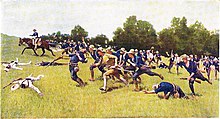 Teddy Roosevelt and the "Rough Riders" charge Spanish positions during the Battle of San Juan Hill. |
|
US-allied victory
|
William McKinley | |
| Philippine–American War (1899–1902) Location: Philippines  Kurz & Allison print of the Battle of Quingua. |
1899–1902 1902-1906
|
1899–1902 Limited Foreign Support:
1902-1906 |
US victory
|
William McKinley (March 4, 1897 – September 14, 1901)
|
| Moro Rebellion (1899–1913) Location: Philippines  The 8th Infantry Regiment defeat the Moros in the four-day battle of Bagsak Mountain on Jolo Island in the Philippines. |
US victory | William McKinley (March 4, 1897 – September 14, 1901)
| ||
| Boxer Rebellion (1899–1901) Location: China  Corporal Titus, of the 14th Infantry Regiment, scaling the walls of Peking. |
US-allied victory
|
William McKinley |
20th-century wars[]
| Conflict | Combatant 1 | Combatant 2 | Result for the United States and its Allies | Presidents of the United States |
|---|---|---|---|---|
| Crazy Snake Rebellion (1909) Part of the American Indian Wars Location: Oklahoma  Creek prisoners of war. |
Creek | US victory | Theodore Roosevelt (September 14, 1901 – March 4, 1909)
Warren G. Harding (March 4, 1921 – August 2, 1923) Calvin Coolidge (August 2, 1923 – March 4, 1929) | |
| Border War (1910–1919) Part of the Mexican Revolution Location: Mexico–United States border  American troops of the 16th Infantry Regiment rest for the night on May 27, 1916 |
US victory
|
William Howard Taft (March 4, 1909 – March 4, 1913)
Woodrow Wilson (March 4, 1913 – March 4, 1921) | ||
| Negro Rebellion (1912) Part of the Banana Wars Location: Cuba  USS Mississippi in Cuba |
US-allied victory
|
William Howard Taft | ||
| Occupation of Nicaragua (1912–1933) Part of the Banana Wars Location: Nicaragua 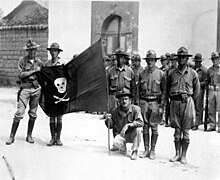 US Marines holding a captured Sandinista flag. |
US-allied victory
|
William Howard Taft (March 4, 1909 – March 4, 1913)
Woodrow Wilson (March 4, 1913 – March 4, 1921) Warren G. Harding (March 4, 1921 – August 2, 1923) Calvin Coolidge (August 2, 1923 – March 4, 1929) Herbert Hoover (March 4, 1929 – March 4, 1933) | ||
| Bluff War (1914–1915) Part of the American Indian Wars Location: Utah and Colorado  Prisoners of the Bluff War in Thompson, Utah, waiting to board a train for their trial in Salt Lake City. |
Ute Paiute |
US victory | Woodrow Wilson | |
| Occupation of Veracruz (1914) Part of the Mexican Revolution Location: Mexico  American ships at Veracruz |
US victory | |||
| United States occupation of Haiti (1915–1934) Part of the Banana Wars Location: Haiti 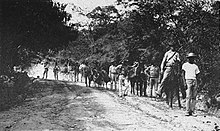 2nd Marine Regiment in Haiti |
US-allied victory | Woodrow Wilson (March 4, 1913 – March 4, 1921)
Warren G. Harding (March 4, 1921 – August 2, 1923) Calvin Coolidge (August 2, 1923 – March 4, 1929) Herbert Hoover (March 4, 1929 – March 4, 1933) Franklin D. Roosevelt (March 4, 1933 – April 12, 1945) | ||
| United States occupation of the Dominican Republic (1916–1924) (1916–1924) Part of the Banana Wars Location: Dominican Republic 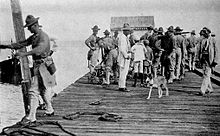 US Marines in the Occupation of the Dominican Republic. |
US victory | Woodrow Wilson (March 4, 1913 – March 4, 1921)
Warren G. Harding (March 4, 1921 – August 2, 1923) Calvin Coolidge (August 2, 1923 – March 4, 1929) | ||
| World War I (1917–1918) Location: Europe, Africa, Asia, Middle East, the Pacific Islands, and coast of North and South America  Two US troops pass by dead German soldiers on a battlefield. |
|
US-allied victory
|
Woodrow Wilson | |
| Russian Civil War (1918–1920) Location: Russia, Mongolia, and Iran  US troops march through Russia before the Battle of Romanovka. |
|
Bolshevik victory
| ||
| Last Indian Uprising (1923) Part of the American Indian Wars Location: Utah  Ute and Paiute prisoners of war. |
Ute Paiute |
US victory | Warren G. Harding | |
| World War II (1941–1945) Location: Europe, Pacific Ocean, Atlantic Ocean, Southeast Asia, East Asia, Middle East, Mediterranean, North Africa, Oceania, North and South America 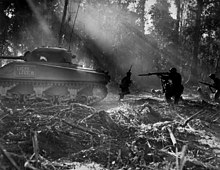 U.S. Army Soldiers advancing at dawn in the cover of a M4 Sherman tank, during the Battle of Bougainville, 1944. |
US-allied victory
|
Franklin D. Roosevelt (March 4, 1933 – April 12, 1945) Harry S. Truman (April 12, 1945 –January 20, 1953) | ||
| Korean War (1950–1953) Part of the Cold War Location: Korea  American soldiers in the Korean War with the Browning M1919A6 LMG. |
Inconclusive/Other Result
|
Harry S. Truman (April 12, 1945 –January 20, 1953)
Dwight D. Eisenhower (January 20, 1953 – January 20, 1961) | ||
| Vietnam War (1955–1964[a], 1965–1973[b], 1974–1975[c]) Part of the Cold War and Indochina Wars Location: Vietnam, Cambodia, and Laos  1st Cavalry Division, Battle of Ia Drang, 1965. |
North Vietnamese-allied victory
|
Dwight D. Eisenhower (January 20, 1953 – January 20, 1961)
John F. Kennedy (January 20, 1961 –November 22, 1963) Lyndon B. Johnson (November 22, 1963 – January 20, 1969) Richard Nixon (January 20, 1969 – August 9, 1974) Gerald Ford (August 9, 1974 – January 20, 1977) | ||
| Laotian Civil War (1953–1975) Part of the Indochina Wars and Cold War Location: Laos  A U.S. Air Force Bell UH-1P from the 20th Special Operations Squadron "Green Hornets" at a base in Laos, 1970. |
Supported by: |
Supported by: |
Pathet Lao-allied victory
| |
| Lebanon crisis (1958) Location: Lebanon  US Marine sits in a foxhole and points his machine gun toward Beirut. |
|
US-allied victory
|
Dwight D. Eisenhower | |
| Bay of Pigs Invasion (1961) Part of the Cold War Location: Cuba |
Cuban government victory (Limited United States Involvement)
| |||
| Dominican Civil War (1965–1966) Location: Dominican Republic  US soldiers push a child underneath a Jeep to protect him during a firefight in Santo Domingo on May 5, 1965. |
|
US-allied victory
|
Lyndon B. Johnson | |
| Korean DMZ Conflict (1966–1969) Part of the Korean conflict and the Cold War Location: Korean Demilitarized Zone  ROK and US troop stationed at the DMZ, 1967. |
US-allied victory
|
Lyndon B. Johnson (November 22, 1963 – January 20, 1969)
Richard Nixon (January 20, 1969 – August 9, 1974) | ||
| Cambodian Civil War (1967–1975) Part of the Cold War Location: Cambodia  US troops and tanks entering town in Cambodia. |
Other Supports
|
Other Supports
|
Khmer Rouge-allied victory
| |
| Multinational intervention in Lebanon (1982–1984) Location: Lebanon  US Marines on patrol in Beirut, April 1983 |
Multinational Force in Lebanon:
|
|
Syrian-Allied Victory
|
Jimmy Carter (January 20, 1977 – January 20, 1981)
Ronald Reagan (January 20, 1981 – January 20, 1989) |
| Invasion of Grenada (1983) Part of the Cold War Location: Grenada  American soldiers in artillery positions at Grenada. |
Military advisors: show
List |
US-allied victory
|
Ronald Reagan | |
| Bombing of Libya (1986) Location: Libya 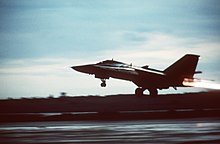 USAF F-111 taking off for Libya |
US victory
| |||
| Tanker War (1987–1988) Location: Persian Gulf  Iranian frigate Sahand after being attacked by U.S. aircraft. |
US victory
| |||
| Invasion of Panama (1989–1990) Location: Panama  U.S. troops prepare to take a neighborhood in Panama City, December 1989. |
US-allied victory
|
George H. W. Bush (January 20, 1989 – January 20, 1993) | ||
| Gulf War (1990–1991) Location: Iraq, Kuwait, Saudi Arabia, and Israel 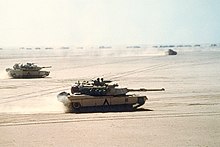 M1 Abrams tanks of the 3rd Armored Division advance on Medina Ridge. |
US-allied victory
|
George H. W. Bush (January 20, 1989 – January 20, 1993) | ||
| Iraqi No-Fly Zone Enforcement Operations (1991–2003) Location: Iraq  A Tomahawk cruise missile is fired from an Arleigh Burke-class destroyer during Operation Desert Fox in December 1998. |
US-allied victory
|
George H. W. Bush (January 20, 1989 – January 20, 1993)
Bill Clinton (January 20, 1993 – January 20, 2001) George W. Bush (January 20, 2001 – January 20, 2009) | ||
| First U.S. Intervention in the Somali Civil War (1992–1995) Part of the Somali civil war (1991–present) Location: Somalia 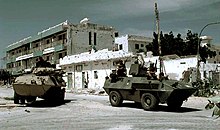 US Marines on patrol in Somalia. |
Inconclusive/Other Result
|
George H. W. Bush (January 20, 1989 – January 20, 1993)
Bill Clinton(January 20, 1993 – January 20, 2001) | ||
| Bosnian War (1992–1995) Part of the Yugoslav Wars Location: Bosnia and Herzegovina  Russian and American troops on a joint patrol around the Bosnian town of Zvornik on the afternoon of February 29, 1996. |
|
Inconclusive/Other Result
| ||
| Intervention in Haiti (1994–1995) Location: Haiti  US troops arrive in Haiti. |
US-allied victory
|
Bill Clinton | ||
| Kosovo War (1998–1999) Part of the Yugoslav Wars Location: Serbia  Bombing of Novi Sad. |
US-allied victory[10][11][12][13]
|
- ^ Advisory role from the forming of the MAAG in Vietnam to the Gulf of Tonkin incident.
- ^ Direct U.S. involvement ended in 1973 with the Paris Peace Accords. The Paris Peace Accords of January 1973 saw all U.S forces withdrawn; the Case–Church Amendment, passed by the U.S Congress on 15 August 1973, officially ended direct U.S military involvement .
- ^ The war reignited on December 13, 1974 with offensive operations by North Vietnam, leading to victory over South Vietnam in under two months.
21st-century wars[]
| Conflict | Combatant 1 | Combatant 2 | Result for the United States and its Allies | Presidents of the United States |
|---|---|---|---|---|
| War in Afghanistan (2001–2021) Part of the War on Terror and the War in Afghanistan (1978–2021) Location: Afghanistan  American and British soldiers take a tactical pause during a combat patrol in the Sangin District area of Helmand Province. |
Formerly: |
Allied groups
Taliban splinter groups
2001 Invasion:
|
Taliban Victory / US-allied defeat
|
George W. Bush (October 7, 2001 – January 20, 2009)
Barack Obama (January 20, 2009 – January 20, 2017) Donald Trump (January 20, 2017 – January 20, 2021) Joe Biden (January 20, 2021 – August 30, 2021) |
| Iraq War (2003–2011) Part of the War on Terror Location: Iraq  Soldiers from 3rd Armored Cavalry Regiment conduct security before a cordon and search operation in Biaj, Iraq with their M1 Abrams Main Battle Tank. |
2003 Invasion: |
US-allied victory
|
George W. Bush (January 20, 2001 – January 20, 2009)
Barack Obama (January 20, 2009 – January 20, 2017) | |
| Second U.S. Intervention in the Somali Civil War (2007–present) Part of the Somali Civil War (1991–present) and the War on Terror Location: Somalia and Northeastern Kenya  MQ-9 Reaper commonly used in covert drone strikes in Somalia. |
|
Hizbul Islam |
Ongoing
|
George W. Bush (January 20, 2001 – January 20, 2009)
Barack Obama (January 20, 2009 – January 20, 2017) Donald Trump (January 20, 2017 – January 20, 2021) Joe Biden (January 20, 2021 –Incumbent) |
| Operation Ocean Shield (2009–2016) Part of the War on Terror Location: Indian Ocean  A tall plume of black smoke rises from a destroyed pirate vessel that was struck by USS Farragut in March 2010. |
Somali pirates | US-allied victory
|
Barack Obama | |
| International intervention in Libya (2011) Part of the Libyan Crisis and the First Libyan Civil War Location: Libya  US vessels launch missiles in support of the First Libyan Civil War. |
US-allied victory
|
Barack Obama | ||
| Operation Observant Compass (2011–2017) Part of the War on Terror Location: Uganda  U.S. Marine Sgt. Joseph Bergeron, a task force combat engineer, explains combat marksmanship tactics to a group of Ugandan soldiers. |
US-allied victory
|
Barack Obama | ||
| American-led intervention in Iraq (2014–present) Part of Operation Inherent Resolve, the Iraqi Civil War, the Spillover of the Syrian Civil War, the War on Terror and the International ISIS campaign Location: Iraq  General Stephen J. Townsend observes a HIMARS strike that destroyed a building near Haditha, September 2016 |
|
Ongoing
|
Barack Obama (January 20, 2009 – January 20, 2017)
Donald Trump (January 20, 2017 – January 20, 2021) Joe Biden (January 20, 2021 –Incumbent) | |
| American-led intervention in Syria (2014–present) Part of Operation Inherent Resolve, the Syrian Civil War, the War on Terror and the International ISIS campaign Location: Syria  USS Ross fires Tomahawk missiles towards Shayrat Military Base, during the 2017 retaliatory strike against the Syrian government. |
Formerly:
|
Supported by: |
Ongoing
|
Barack Obama (January 20, 2009 – January 20, 2017)
Donald Trump (January 20, 2017 – January 20, 2021) Joe Biden (January 20, 2021 –Incumbent) |
| American intervention in Libya (2015–2019) Part of the Second Libyan Civil War, the War on Terror, and the International ISIS Campaign Location: Libya 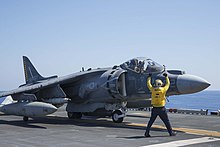 USS Wasp conducts flight operations in Operation Odyssey Lightning. |
ISIS in Libya largely defeated
|
Barack Obama (January 20, 2009 – January 20, 2017)
Donald Trump (January 20, 2017 – January 20, 2021) |
See also[]
- Military history
- Timeline of United States military operations
- United States involvement in regime change
- List of ongoing armed conflicts
Notes[]
- ^ These numbers are gathered from a combination of surviving muster rolls and veteran applications for land grants. It is likely that the statistics on the Texan army size in both 1835 and 1836 underestimate the number of Tejanos who served in the army. American volunteers who returned to the U.S. without claiming land are also undercounted. Lack (1992), p. 113.
References[]
- ^ history, Martin Kelly Martin H. Kelly is a former; Teacher, Social Studies; Books, The Author of Two History; life, one on Colonial; Tampa, the other on American Presidents He is an online course developer for the UK-based Pamoja Education company He lives in; Florida. "American Involvement in Wars from Colonial Times to the Present". ThoughtCo. Retrieved May 17, 2019.
- ^ Jump up to: a b c d e f "Tripolitan War | Encyclopedia.com". www.encyclopedia.com. Retrieved May 8, 2019.
- ^ Jump up to: a b r2WPadmin. "First Barbary War". American History Central. Retrieved May 8, 2019.
- ^ Serial 89, 18th Congress, 1st Session, Senate Document No. 1, p. 95
- ^ Lack (1992), pp. 122–3.
- ^ "City of Albuquerque". City of Albuquerque.
- ^ Yun, Jiwon (2019). "Vietnam's Politic of a Divided Nation: From the Reunification to DoiMoi (Renovation) and Its Implication for the Korean Peninsula and North Korea". International Journal of Korean Unification Studies. 28 (1): 63–92. doi:10.33728/ijkus.2019.28.1.003. Retrieved September 24, 2020.
- ^ "Statement by Deputy Press Secretary Larry Speakes". September 23, 1982.
- ^ "The Collapse of Lebanon's Army: U.S. Said to Ignore Factionalism". March 11, 1984.
- ^ http://www.dtic.mil/dtic/tr/fulltext/u2/a432768.pdf
- ^ Cambridge Scholars Publisher (2015). Coercive Diplomacy of NATO in Kosovo. Cambridge Scholars Publishing. pp. 289–. ISBN 978-1-4438-7668-1.
- ^ Erlanger, Steven (November 7, 1999). "NATO Was Closer to Ground War in Kosovo Than Is Widely Realized" – via NYTimes.com.
- ^ Lake, Daniel R. (2009). "The Limits of Coercive Airpower: NATO's "Victory" in Kosovo Revisited". International Security. 34: 83–112. doi:10.1162/isec.2009.34.1.83. S2CID 57572298.
- ^ "Central Asian groups split over leadership of global jihad". The Long War Journal. August 24, 2015. Retrieved August 27, 2015.
- ^ "Sectarian divisions change Baghdad's image". NBC News. July 3, 2006. Retrieved February 18, 2007.
- ^ Petrou, Michael (September 9, 2011). "The decline of al-Qaeda". Maclean's.
George W. Bush gambled on surging thousands more troops to the embattled country. It paid off. Al-Qaeda in Iraq is now a diminished force without territory.
- ^ Spencer C. Tucker (December 14, 2015). U.S. Conflicts in the 21st Century: Afghanistan War, Iraq War, and the War on Terror. ISBN 978-1-4408-3879-8.
Al Qaeda in Iraq was decimated by the end of the Iraq War in 2011
- ^ South, Todd (January 20, 2019). "Army's long-awaited Iraq war study finds Iran was the only winner in a conflict that holds many lessons for future wars". Army Times. Retrieved January 20, 2019.
- ^ Galbraith, Peter W. (2007). The End of Iraq: How American Incompetence Created a War Without End. Simon & Schuster. p. 74. ISBN 978-0-7432-9424-9.
- ^ "Iran expands regional 'empire' ahead of nuclear deal". Reuters.
- ^ "How to Stop Iran's Growing Hegemony". National Review Online.
- ^ "The JRTN Movement and Iraq's Next Insurgency | Combating Terrorism Center at West Point". Ctc.usma.edu. Archived from the original on August 26, 2011. Retrieved August 2, 2014.
- ^ "Al-Qaeda's Resurgence in Iraq: A Threat to U.S. Interests". U.S. Department of State. February 5, 2014. Retrieved November 26, 2010.
- ^ Jump up to: a b c "Service and Sacrifice: Ugandan 'Blue Helmets' support UN efforts to bring peace to Somalia". UN News. April 18, 2019. Retrieved April 18, 2019.
- ^ Somalia, EUTM. "Home". EUTM-Somalia. Retrieved April 18, 2019.
- ^ "Somali piracy is down 90 per cent from last year". The Journal. December 15, 2013. Retrieved January 14, 2014.
- ^ Holmes, Oliver (January 24, 2012). "UPDATE 1-Anger, chaos but no revolt after Libya violence". Bani Walid. Reuters Africa. Archived from the original on April 30, 2012. Retrieved January 24, 2012.
- ^ "IS left 200 mass graves in Iraq - UN". November 6, 2018. Retrieved June 21, 2019.
- ^ Reuters (June 15, 2019). "Belgium takes back six children of Isis fighters from Syrian camps". The Guardian. ISSN 0261-3077. Retrieved June 15, 2019.
- ^ "US-led Coalition in Iraq & Syria". Airwars. December 2018. Retrieved January 4, 2019.
External links[]
- Heidelberg Institute for International Conflict Research (HIIK)
- Conflict Barometer – Describes recent trends in conflict development, escalations, and settlements
- A Continent Divided: The U.S.-Mexico War[permanent dead link], Center for Greater Southwestern Studies, the University of Texas at Arlington
- Timeline of wars involving the United States, Histropedia
- U.S. Periods of War and Dates of Recent Conflicts, Congressional Research Service
- Wars involving the United States
- Lists of wars by country
- United States history-related lists
- United States military-related lists
